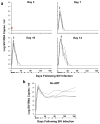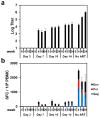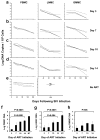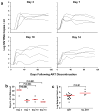Rapid seeding of the viral reservoir prior to SIV viraemia in rhesus monkeys
- PMID: 25042999
- PMCID: PMC4126858
- DOI: 10.1038/nature13594
Rapid seeding of the viral reservoir prior to SIV viraemia in rhesus monkeys
Abstract
The viral reservoir represents a critical challenge for human immunodeficiency virus type 1 (HIV-1) eradication strategies. However, it remains unclear when and where the viral reservoir is seeded during acute infection and the extent to which it is susceptible to early antiretroviral therapy (ART). Here we show that the viral reservoir is seeded rapidly after mucosal simian immunodeficiency virus (SIV) infection of rhesus monkeys and before systemic viraemia. We initiated suppressive ART in groups of monkeys on days 3, 7, 10 and 14 after intrarectal SIVMAC251 infection. Treatment with ART on day 3 blocked the emergence of viral RNA and proviral DNA in peripheral blood and also substantially reduced levels of proviral DNA in lymph nodes and gastrointestinal mucosa as compared with treatment at later time points. In addition, treatment on day 3 abrogated the induction of SIV-specific humoral and cellular immune responses. Nevertheless, after discontinuation of ART following 24 weeks of fully suppressive therapy, virus rebounded in all animals, although the monkeys that were treated on day 3 exhibited a delayed viral rebound as compared with those treated on days 7, 10 and 14. The time to viral rebound correlated with total viraemia during acute infection and with proviral DNA at the time of ART discontinuation. These data demonstrate that the viral reservoir is seeded rapidly after intrarectal SIV infection of rhesus monkeys, during the 'eclipse' phase, and before detectable viraemia. This strikingly early seeding of the refractory viral reservoir raises important new challenges for HIV-1 eradication strategies.
Conflict of interest statement
The authors declare no competing financial interests.
Figures













Comment in
-
HIV: Early treatment may not be early enough.Nature. 2014 Aug 7;512(7512):35-6. doi: 10.1038/nature13647. Epub 2014 Jul 20. Nature. 2014. PMID: 25043038 No abstract available.
-
Viral infection: Seeding the HIV-1 reservoir.Nat Rev Microbiol. 2014 Sep;12(9):594. doi: 10.1038/nrmicro3342. Nat Rev Microbiol. 2014. PMID: 25271335 No abstract available.
References
-
- Finzi D, et al. Latent infection of CD4+ T cells provides a mechanism for lifelong persistence of HIV-1, even in patients on effective combination therapy. Nat Med. 1999;5:512–517. - PubMed
-
- Zhang L, et al. Quantifying residual HIV-1 replication in patients receiving combination antiretroviral therapy. N Engl J Med. 1999;340:1605–1613. - PubMed
-
- Chun TW, Davey RT, Jr, Engel D, Lane HC, Fauci AS. Re-emergence of HIV after stopping therapy. Nature. 1999;401:874–875. - PubMed
-
- Chun TW, et al. Quantification of latent tissue reservoirs and total body viral load in HIV-1 infection. Nature. 1997;387:183–188. - PubMed
Publication types
MeSH terms
Substances
Grants and funding
- U19 AI078526/AI/NIAID NIH HHS/United States
- UM1 AI100645/AI/NIAID NIH HHS/United States
- AI096040/AI/NIAID NIH HHS/United States
- T32 AI007245/AI/NIAID NIH HHS/United States
- AI100645/AI/NIAID NIH HHS/United States
- R01 AI084794/AI/NIAID NIH HHS/United States
- AI078526/AI/NIAID NIH HHS/United States
- AI060354/AI/NIAID NIH HHS/United States
- U19 AI096040/AI/NIAID NIH HHS/United States
- P30 AI060354/AI/NIAID NIH HHS/United States
- R56 AI091514/AI/NIAID NIH HHS/United States
- UM1 AI100663/AI/NIAID NIH HHS/United States
- AI095985/AI/NIAID NIH HHS/United States
- AI084794/AI/NIAID NIH HHS/United States
- U19 AI095985/AI/NIAID NIH HHS/United States

